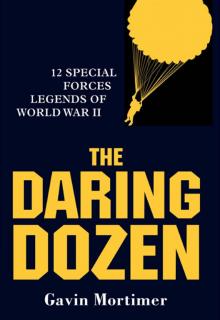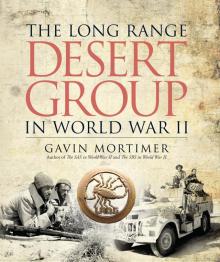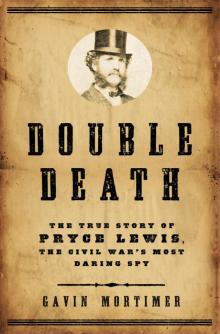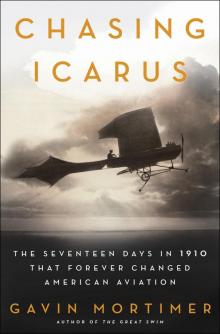- Home
- Gavin Mortimer
The Long Range Desert Group in World War II Page 3
The Long Range Desert Group in World War II Read online
Page 3
__________
The landscape could change rapidly from flat, hard gravel surface into broken, hilly country. (Courtesy of the SAS Regimental Archive)
Bagnold had his unit ready for action within the six weeks allotted by General Wavell. The officer afforded the privilege of leading the inaugural patrol was Pat Clayton, who drove out of Cairo on 7 August in two Chevrolet trucks with a handpicked party of seven. They journeyed west, motoring across the Italian routes leading from the coast to Kufra and the south, and returned to the Egyptian capital without mishap 12 days later, having travelled 1,600 miles in 13 days. ‘We had, as hoped and intended, not fired a shot or seen the enemy,’ reflected Clayton. ‘But we had proved that [we] could go and come back to a strict timetable.’19 The patrol had also discovered a hitherto unmapped strip of sand sea, 100km wide, immediately east of the Jalo–Kufra road.
The next day, 20 August, Clayton and Bagnold briefed General Wavell on the first sortie of the unit – provisionally designated the Long Range Patrol – and such was his admiration for their achievements Wavell ‘made up his mind then and there to give us his strongest backing’.20
C HAPTER 3
INTO ACTION
Bagnold divided his unit into three patrols, assigning to each a letter of no particular significance. W Patrol was commanded by Captain Teddy Mitford, captains Pat Clayton and Bruce Ballantyne (a New Zealander) were the officers in charge of T Patrol, and Captain Don Steele, a farmer from Wellington, led R Patrol. Each patrol consisted of two officers, around 30 other ranks, transported in 11 30cwt Chevrolet trucks and a light 15cwt Ford V8 pilot car. Each patrol was armed with a 37mm Bofors anti-tank gun, four Boys anti-tank rifles and 11 Lewis guns, the gas-operated weapon from World War I.
Axis forces feared the desert interior, preferring to stick to the coastal roads, but Bagnold taught the LRDG that, if respected, the desert could be a useful ally. (Courtesy of the SAS Regimental Archive)
Rations (which were packed in wood petrol cases when the LRDG was on a patrol) were of particular concern to Bagnold, based on his own experience, and Kennedy Shaw was responsible for devising the unit’s diet while ‘up the blue’, army slang for on operations in the desert. ‘Knowing that we should often get no fresh meat or bread or vegetables for weeks or months on end, we needed a special ration scale,’ he said. Tracking down back issues of Geographical Journal, Kennedy Shaw used the scales listed in the magazine by Harding-Newman in his accounts of his desert expeditions in the 1930s. ‘Using these and the kinds of food provided by the Army in the Middle East, I increased the amounts of some, reduced others, and sent the result to the medical people,’ explained Kennedy Shaw.1 The scale was approved and a sample menu drawn up that became the template for all British special forces units for the rest of the war. It comprised:
Breakfast suggestions
Porridge (no milk or sugar)
Fried bacon with oatmeal fritter
Bacon and oatmeal cake
Bacon stuffed with cooked oatmeal
Bacon with oatmeal chappatties [sic]
Tiffin
Lentil soup
Various sandwich spreads on biscuits
Cheese and oatmeal savoury
Cheese and oatmeal cake
Oatmeal and date cookies
Dinner
Stewed mutton with dumplings
Meat pudding
Major Don Steele, left, the New Zealand officer who commanded R Patrol, and Colonel Guy Prendergast, who replaced Bagnold as the LRDG CO in August 1941. (Courtesy of the SAS Regimental Archive)
The water ration was then six pints a day, wrote Kennedy Shaw, ‘one in tea at breakfast, two in tea in the evening, one in lime-juice at lunch, and two in your water-bottle to be drunk at will’. The ration was sufficient in winter but a test of discipline in the summer. There were times, when the sun was at its fiercest, when water was the only topic of conversation. The men talked about the best way to conserve their six pints: some recommended small sips at regular intervals, others said large gulps less frequently worked best. One or two men liked to damp a handkerchief with a few drops of water and press it to their forehead or neck. The more elaborately minded left their water in a thermos overnight so the water was cool in the morning.
In the first week of September, Bagnold and his unit embarked on their first operation. The Italians, after three months of inactivity, had finally advanced east, crossing the Egyptian frontier as far as Sidi Barrani, approximately 45 miles west of the British position at Mersa Matruh. Bagnold decided to head into the Libyan Desert to discover if the enemy was on the move towards Kufra and a possible strike into Egypt from the south. It was just the sort of reconnaissance that Wavell had in mind when he authorized the formation of the Long Range Patrol. On 5 September, Bagnold, Kennedy Shaw and a small HQ patrol left Cairo in the company of Mitford’s W Patrol, comprised entirely of Kiwis. Pat Clayton’s T Patrol, also containing New Zealanders, included among its ranks trooper Frank Jopling, an English-born 28-year-old farmhand from Auckland.
On Clayton’s first short reconnaissance of the desert the previous month, he had been a little perturbed to discover that several of the New Zealanders had brought cameras with them, as if they were tourists on a jolly excursion. Subsequently an order had been issued by Bagnold that cameras and diaries were strictly forbidden on any operation into enemy territory. Jopling ignored the command, commencing a journal from the first day that he entitled, ‘Our First Trip Into Action’. As he recorded, it wasn’t the most auspicious of debuts:
5th Sept. 1940: Well, well, well, what organisation!! and what a start for a history-making trip. We were all lined up and all ready to move off when they suddenly decided that the 15cwt V8s were no good the way they were as when they loaded them up, the tyres hit the mudguards so they decided that they would have to take them to Ordnance and get them altered. So we were told that we wouldn’t be leaving until 4.0 p.m.2
The V8s were the Ford pilot cars that by the end of the year had been largely discarded because they lacked durability and their engines frequently clogged with sand. On this afternoon, however, the first ones to be repaired belonged to HQ and W Patrol, and they moved off at 2pm. Jopling’s T Patrol followed a short while later, the soldiers grouching at the delay. ‘Not necessarily because we want to have a go at the Italians,’ wrote Jopling, ‘but more for the adventure and the excitement of the trip. We are going where no trucks have ever been before over country that has never been mapped, we will probably see things that have never been seen by white men.’3
An early LRDG patrol with the lead vehicle an American Chevrolet. Note the windshields and what appears to be the pith helmet worn by the soldier. (Courtesy of Jack Valenti)
The vehicles drove through the afternoon and into the early evening, the men transfixed by the changing colours of the desert as the sun began its descent. They stopped for the night at 7.30pm having covered 123km, R, T and W patrols camping in different spots among the dunes. They then embarked on what would become in time an all-too-familiar routine. Two of the patrol began to cook supper, or ‘tea’ as Jopling called it, and as the smells began to waft tantalizingly around the vehicles the navigator finished plotting the dead reckoning of their day’s travel and then confirmed their position by taking a snap shot of the stars with his theodolite. The gunners examined their weapons and cleaned them if necessary, and the drivers and fitters (Jopling’s role) checked the tyre pressures, lubricating oil, petrol and water. They would also check for any signs of wear and tear to the vehicle and any damage would be reported to the navigator, who in turn would brief the patrol commander. The most important item was water, because if it was ever found that there was shortage – leaky jerrycans, for example – then the patrol would have to be closed down and returned to base. Only when all the tasks had been accomplished to the commander’s satisfaction could the men tuck into their food. On the evening of 5 September, Jopling and his comrades were treated to ‘bully beef, spuds, onion
s and peas and curry, all made into a stew’.
An LRDG patrol traverses the Libyan Desert. The vehicles kept a good distance between each other in case of aircraft attack. (Author’s Collection)
Captioned originally ‘Stuck on a razorback’, this photo shows three LRDG soldiers discussing the best method to extricate their vehicle from the crest of the sand dune. (Author’s Collection)
The night passed uneventfully, as did the following day, as Jopling described in his diary.
6th Sept. 40
12-0 noon.*
I am afraid I have had neither the time nor opportunity to write this sooner. We got up at 6-0 a.m and set off at 8-0 a.m. We couldn’t very well start earlier as clouds hid the sun and it is very slow going without the sun compass. We have now done 134 kilos [sic] over very rough going. I hope it is better this afternoon. They are putting the scrim and nets over the trucks now and they look very effective. ‘W’, ‘R’ and ourselves are all here but we will be parting from the ‘W’ Patrol any time now. We are having sardines and tinned fruit for lunch, which sounds all right to me just at present.
6-0 p.m. We have again stopped for the night near some sand dunes after having travelled 257 kilos since breakfast, which is the biggest mileage we have put up in one day since there was such a force as an LRP [Long Range Patrol].
It has been very rough and soft all day except the last 20 kilos which has been very good. The poor old truck has had to work hard today and has been boiling most of the time.
There is another stew on tonight but I like them very much.
Well, I must stop now before I get caught.4
In the days that followed, the three patrols laid petrol and supply dumps along the Libyan frontier so that they would be able to operate in and around Kufra and Uweinat without having to return to Egypt for a resupply. T and R patrols transported 7,000 gallons of petrol across the hardest tract of the Sand Sea from Siwa Oasis to a pre-war landmark called Big Cairn on the western fringe. The Cairn was five feet high, the only feature in a flat monotonous gravel plain between two sand seas. It had been built by Pat Clayton in 1932 and now it was used as a beacon for a supply dump of petrol and water.
Meanwhile Kennedy Shaw oversaw the laying of a petrol dump beyond ‘Ain Dalla, on the eastern edge of the Sand Sea. He had last visited ‘Ain Dalla in 1930 and it hadn’t changed in the intervening decade. The stunted palms, the decrepit wooden hut and the refreshing waters of its spring. The route to ‘Ain Dalla was what Kennedy Shaw called the ‘underground road to Libya’, allowing those daring enough to travel on it to enter Libya from Cairo without being spotted because it was ‘guarded by the sand sea which the Italians would never expect us to cross’.
Once all the supply dumps were in place, the patrols split up. Clayton headed south towards the French frontier in Tekro, 600 miles south, Steele returned to Siwa to ferry more supplies to the Big Cairn, and Mitford and Kennedy Shaw drove east towards the Kalansho Sand Sea in the direction of Kufra.
En route they were confronted by dunes as high as 300 feet in a range that stretched for 20km. Kennedy Shaw and Mitford led by example, demonstrating to the Kiwis the safest way to surmount a dune – by accelerating up the slope, then slowing near the top and stopping on the crest with all four wheels in line. Then it was a question of toppling the truck gently over the edge of the precipice, so the vehicle sailed down the sand axle-deep in first gear to the bottom. Never, warned the two explorers, accelerate over a dune, because ‘in a flying leap from the crest the car turns over and over’.†
On September 16 a qibli descended on Mitford’s patrol, the Libyan name for the hot wind peculiar to the region. Kennedy Shaw had experienced the Egyptian khamsin, but that seemed mild compared to the suffocating heat of the qibli. ‘You don’t merely feel hot,’ he recalled. ‘You don’t merely feel tired, you feel as if every bit of energy had left you, as if your brain was thrusting its way through the top of your head and you want to lie down in a stupor till the accursed sun has gone down.’5 Often men were sick after supper because of the effects of a qibli, their digestion in turmoil. It was the Rhodesians who eventually discovered what came to be known as the ‘anti-qibli pick-me-up’. It consisted of equal parts of rum and lime-juice, and the men swore by its medicinal powers.
The qibli lasted three days and it wasn’t until 20 September that the men began to breathe freely once more. On the same day they ran into their first Italians. ‘While we were following the track to Kufra near the LG [Landing Ground No. 7] there appeared, churning slowly through the soft sand, two six-ton lorries of the Italian firm of Trucci and Monti, the fortnightly convoy to Kufra,’ said Kennedy Shaw.6 Mitford ordered his men to fire a burst from the machine gun over the lead truck, thus giving W Patrol the honour of firing the unit’s first shots in anger. But that was the extent of the ‘battle’. The two vehicles braked hard and out stumbled two Italians and four native troops, and a goat. Mitford dismounted and he and his men took stock of their prisoners. They were a sorry-looking bunch. One of the Italian drivers spoke English, the rest just grinned nervously. It was hard not to feel a smidgen of sympathy for the native soldiers, caught up in a European war and armed with hopelessly inadequate weapons. One complained that his wife wouldn’t be happy to hear he’d been captured. Mitford reassured the soldier ‘that he will be allowed to write and explain his absence to his wife’.7 Inside the trucks the New Zealanders discovered 2,500 gallons of petrol, a lot of medical supplies, a quantity of shirts and mats and, most importantly, a bag of official mail. That provided useful information, as did the prisoners, who informed their captors that the Italians had recently despatched 6,250 soldiers to Uweinat.
Mitford’s patrol reached Cairo on 4 October. Bagnold described them as ‘bearded, unwashed but exultant ruffians’, the stench from their ragged uniforms so overpowering that most had to be peeled off their bodies and burned.
Pat Clayton’s T Patrol had also sported extravagant beards on arriving back at Abbassia Barracks on 1 October. In the three weeks since they had parted company with the other two patrols, Frank Jopling had stayed faithful to his diary, recording their adventure daily.
13th Sept. 40.
We are 347 kilos South of SIWA now. We are all enjoying this trip and not one of us would change places with any man in any army. I have since found out that the first 60 kilos from SIWA as far as is known, have never been crossed by white men.
14th Sept. 40.
10-0 a.m. This morning I started doing maintenance on the truck but the wind got up and started a sand storm. This sand is a sort of fine pebbles, and believe me, when it is travelling at 30 or 40 MPH it can sting. However, we had to give up the maintenance and we have rigged up as good a shelter as possible and we are now going to have a spell. The sand still seems to come through but it is better than nothing.8
On 15 September, T Patrol crossed the Egyptian border and by the end of the day they were some 100km inside Libya. Jopling stood guard from 9pm to 10pm and passed some of the time listening to Lord Haw-Haw on the wireless.‡ The next day, 16 September, the patrol encountered the qibli that had so enervated Bill Kennedy Shaw and his men. Jopling judged the temperature to be ‘at least 130º in the shade’, but noted in his diary that everyone remained in good spirits.
They set off early the following day before the desert became too great a furnace and by 9am had covered nearly 100km. Double tyre tracks were spotted and followed, leading to what Jopling described as an outpost. Clayton instructed the men to prepare for action and the patrol then charged the target as if they were a band of marauding tribesmen on camels. But the target never defended itself and when they got closer, Clayton saw it was an emergency landing ground for Italian aircraft. There was a palpable sense of anti-climax among the New Zealanders. ‘We were all keyed up now,’ recorded Jopling, ‘and were scanning the horizon for anything that may come over the top.’ But nothing appeared and the men drove off in frustration. Over lunch Clayton told the men to cheer up; tomo
rrow they would make for Naarten Bisciara, a well that was guarded by Italians. They’d have their chance for a scrap then.
An LRDG patrol in late 1940, again, thought to be en route to Murzuk in January 1941. (Courtesy of Jack Valenti)
But once again the enemy proved elusive. ‘We made a spectacular charge only to find that there was no one there and we had the well to ourselves,’ wrote Jopling in his diary. This time the disappointment was diminished by the urge to draw water from the well. It was a challenge. The water, Jopling estimated, was 180ft below the lid of the well, but there was a pulley, to which the New Zealanders attached the bottom half of a jerrycan. Slowly, carefully, the men hauled up the first bucket of water. It tasted ‘beautiful’, and there was even enough with which to have a good wash.9§
Reinvigorated, Jopling was better able to appreciate the desolation of their location. Few men of their civilization had ever stood in such a remote spot. Siwa was 800 miles distant. Scattered around the well was a carpet of bones. Clayton explained to the men that some were the carcasses of sheep and goats, killed by nomads for food as they camped at the well; other bones belonged to camels that were too weak to continue and had therefore also been sacrificed for food.
The next day, 19 September, they launched a third fruitless attack on a target that turned out to be a shelter for nomadic camel trains. There was another well, one which was measured at 500 feet deep. ‘It makes one wonder how it was ever made,’ wrote Jopling, who discovered a dead snake close to the well. He showed it to Clayton, who identified it as a horned viper. ‘Is it poisonous?’ asked the Kiwi. ‘Deadly,’ replied the officer.

 The Daring Dozen
The Daring Dozen The Long Range Desert Group in World War II
The Long Range Desert Group in World War II Double Death
Double Death Chasing Icarus
Chasing Icarus